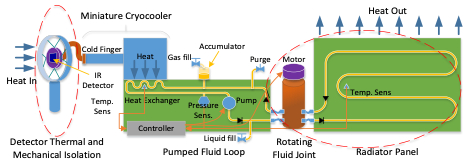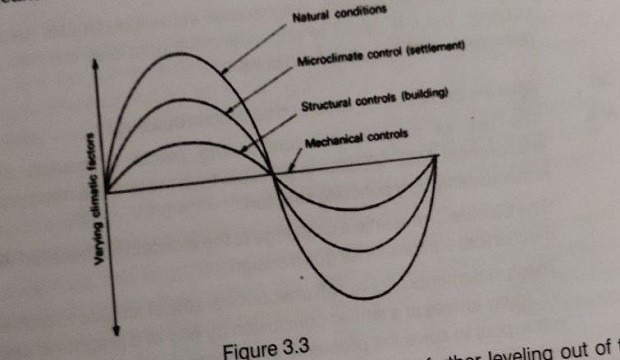What are the various objectives of thermal control
The objective of thermal controls are as follows:
1. When cold discomfort conditions prevail:
a. to prevent heat loss
b. to utilize heat gained from the sun and internal sources
c. to compensate for any net loss, by heating which uses some form of energy supply

2. When hot discomfort conditions prevail:
a. to prevent heat gain
b. to maximize heat loss
c. to remove any excess heat by cooling, which uses some form of energy supply
3. When conditions vary diurnally between hot and cold discomfort:
a. to even out variations
b. (1) in the cold phase and (2) in the hot phase (as above)
c. to compensate for both excesses by a flexible heating cooling systems Objectives listed under a and b in each group can be achieved by structural or constructional (passive) means, itern a in each group is the task of mechanical or energy-based (active) controls.
Explain the degree of control under various conditions.
Under extreme conditions, when human existence is at risk, mechanical controls are positively necessary.
When the conditions are such that only the degree of comfort is in question when the risk is a slight discomfort-the use of mechanical controls is optional.
As D H K Lee expresses it the degree of sophistication (in environmental controls) is largely a socio-economic question’ in other words.

we are capable of creating and maintaining any specified set in indoor conditions, but both our preference and the refinement of control- installations will depend on our social status, on the standards of the society we live in, and on the financial means at our disposal.
A value judgment will be involved in deciding what degree of comfort we want to achieve and how much we are prepared to pay for it.
The environment immediately outside and between buildings can be influenced by the design of a settlement and by the grouping of building to a minor extent Figure 3.3 shows that the extremities of climatic variations can be attenuated by such means.
Structural (passive) means of control can provide a further leveling out of the climatic variations, and often even comfort conditions can be achieved by such means.
Precisely controlled indoor climate can only be achieved by mechanical (active) controls (the straight line in Figure 3.3).
But this may not be our aim, and even if it is, with adequate structural controls, the task of mechanical controls is radically reduced and it becomes more economical.
What are the various problem associated with heating?
Heating may be the answer to an environmental problem, but it will create some of its own problems.
Distribution of heat, evenly, throughout the heated space is not an easy task.
The temperature gradient between areas of concentrated heat loss (e. g windows) and the zone of the heat output units may be so steep that strong convection currents (draughts) are generated, adversely affecting comfort conditions and causing, for instance, discoloration of the surface.
What are the various objectives of thermal control
Dryness (very low humidity) is a result of heating. When cool air of medium humidity is heated, its relative humidity is decreased.
For example, air at 0 °C DBT and 60% RH, heated to 20°C DBT, will cause the RH to drop to 15%.
Condensation can be caused indirectly. The warm indoor air will really take on moisture from any available source: human exhalation (around 45 g/h per person), cooling, kettles, baths, etc.
Its RH increases, and consequently its dewpoint temperature is also increased.
Air at 20°C DBT and 80 %RH will have a dewpoint temperature of 16.5°C. It only needs to come into contact with a surface of 16°C and condensation will appear.
Interstitial condensation may soak the wall material and increase its conductivity, thus lowering the wall surface temperature, which in turn further increase the condensation.
None of this problem is likely to arise in tropical climates (except with artificial cooling), but it is useful to understand the principles involved, which may be relevant under any sort of conditions.
What are the needs for structural controls in building?
The use of massive air conditioning plants to correct an ill-conceived environment does not differ in principle from the use of a masonry façade to hide unnecessarily ugly concrete structures.
The Climate… presents a challenge to the architect not satisfied with substituting mechanical equipment for good design’.
These statements express an unequivocal ethical attitude to architectural design. V Olgyay arrives at a similar conclusion by way of a pragmatic approach:
We do not expect to solve the problems of uncomfortable conditions by natural means only. The environmental elements aiding us have their limits.
But it is expected that the architect should build the shelter in such a way as to bring out the best of the natural possibilities.
ET Weston sums it up most poignantly: The less plant and fuel, the more satisfactory the result.
Referring to Figure 3.3, we could summaries the task of environmental controls as follows.
To ensure the best possible indoor thermal conditions by relying on structural (passive) controls, which may obviate the need for any mechanical (active) controls, but even if mechanical controls do have to be resorted to, their task will thereby be reduced to a minimum.
How the thermal insulation is used for controlling the thermal environment? Also, explain the thermal capacity along with this.
A construction with a low U-value (air-to-air) transmittance will reduce all forms of conduction, and heat transfer through the building envelope.
Such a conduction heat flow would be large if the temperature difference were large With small temperature differences between the inside and outside, the heat flow would be small anyway; an improvement in thermal insulation would not bring any significant reduction.
However, it is worth remembering, that in a heat gain situation, with strong solar radiation, it is the sol-air temperature value that must be used to find the temperature difference acting as a motive force for heat flow that may be large, consequently, insulation may be important.
Insulation will be most effective under steady-state conditions, or if the direction of the heat flow is constant for a long period of time- especially for heated or air-conditioned buildings.
Where the direction of heat flow is twice reversed in every 24-hour cycle, the significance of insulation will be diminished.
Under conditions with large diurnal temperature variations, the significance of thermal capacity will be much greater than the insulation.
Some authors refer to the effect of thermal capacity, as capacitive insulation, as opposed to resistive insulation provided by low-conductivity materials and low-transmittance constructions.
The theory of periodic heat flow and the concepts of time-lag and decrement factor has been introduced in section 3.3.Here we can set the question:
“How much thermal capacity, what length of time-lag, is desirable? A point is often over.
For example, a wall facing east receives its maximum heating at 10.00 hours. A time- lag of 10 hours would put the inside surface temperature maximum may want to sleep but cannot.
The question can be answered by drawing a graph of the outdoor (sol-air) temperature variations for each wall and establishing from this at what time will be maximum indoor heating effect be required or tolerated.